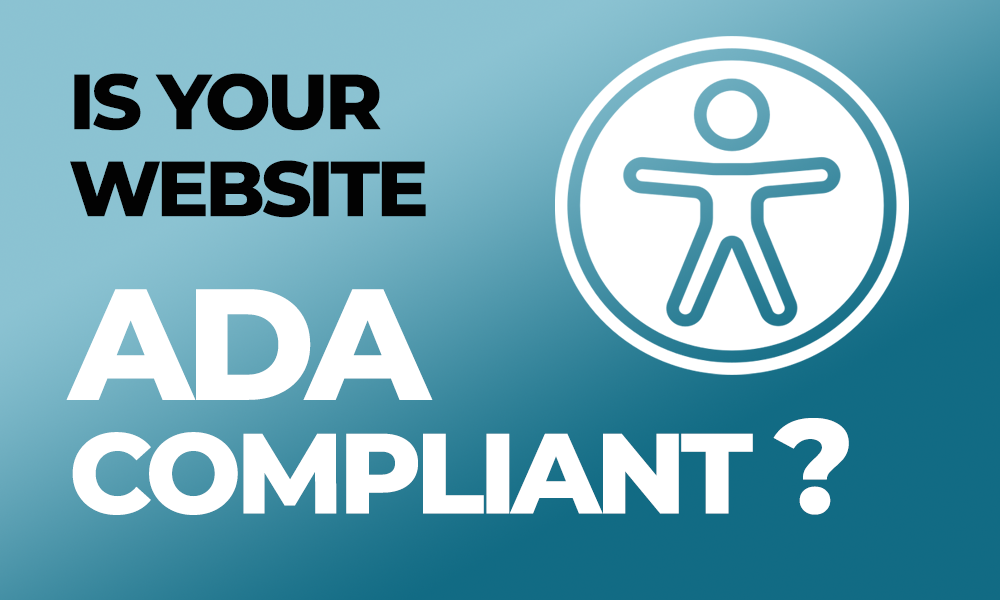Is Your Website ADA Compliant?
What does Website Accessibility mean?
Website Accessibility ensures that people with disabilities are not denied equal access to information. An inaccessible website can exclude people just as much as steps at an entrance to a physical location can. Basic information that is needed on a daily basis is now found online, such as making an appointment at a doctor’s office or reading a train schedule, and must be accessible to all.
Who needs to be ADA Compliant?
According to the US Department of Justice, The Americans with Disabilities Act of 1990 protects those with disabilities against discrimination in places of public accommodation. Websites are now considered places of public accommodation and should not include any barriers when performing activities such as reading, seeing and communicating.
The Act is segmented into 2 sectors: state and local governments (Title II) and businesses that are open to the public (Title III).
State and local governments (Title II)
Title II of the ADA prohibits discrimination against people with disabilities in all services, programs, and activities of state and local governments. State and local governments must take steps to ensure that their communications with people with disabilities are as effective as their communications with others. Many state and local government services, programs, and activities are now being offered on the web. These include, for example, things like:
- Applying for an absentee ballot
- Paying tickets or fees
- Filing a police report
- Attending a virtual town meeting
- Filing tax documents
- Registering for school or school programs
- Applying for state benefits programs
A website with inaccessible features can limit the ability of people with disabilities to access a public entity’s programs, services and activities available through that website—for example, online registration for classes at a community college.
For these reasons, the Department has consistently taken the position that the ADA’s requirements apply to all the services, programs, or activities of state and local governments, including those offered on the web.
Businesses that are open to the public (Title III)
Title III prohibits discrimination against people with disabilities by businesses open to the public (also referred to as “public accommodations” under the ADA). The ADA requires that businesses open to the public provide full and equal enjoyment of their goods, services, facilities, privileges, advantages, or accommodations to people with disabilities. Businesses open to the public must take steps to provide appropriate communication aids and services (often called “auxiliary aids and services”) where necessary to make sure they effectively communicate with individuals with disabilities. For example, communication aids and services can include interpreters, notetakers, captions, or assistive listening devices. Examples of businesses open to the public:
Retail stores and other sales or retail establishments;
- Banks
- Hotels, inns, and motels
- Hospitals and medical offices
- Food and drink establishments
- Auditoriums, theaters, and sports arenas.
A website with inaccessible features can limit the ability of people with disabilities to access a public accommodation’s goods, services, and privileges available through that website—for example, a veterans’ service organization event registration form.
For these reasons, the Department has consistently taken the position that the ADA’s requirements apply to all the goods, services, privileges, or activities offered by public accommodations, including those offered on the web.
How do I know if my website is ADA Compliant?
Make sure your website does not have any of the following Accessibility Barriers:
My website is not ADA compliant, now what do I do?
Website ADA Compliance Audit
We will perform an audit on your website that tests for any barriers. You will be provided with a detailed report that outlines any problems found and a plan of action to fix those issues. Along with manual fixes that we perform, we have partnered with Accessibe. Accessibe is a tool that is installed on the website and allows the visitor to adjust the user interface according to their needs, optimizing the site for screen readers and keyboard navigation.
We have found that implementing the manual changes along with adding the Accessibe software to the site, is an affordable and effective way to achieve compliance.
Keep in mind maintaining accessibility is an ongoing effort and we will help you have a plan in place for long-term compliance. We stand by our clients to provide them with guidance, tools and solutions to keep pace with this ever changing digital world.
This article is for informational purposes only and does not constitute legal advice.
Request more information on our ADA Compliance Audit

